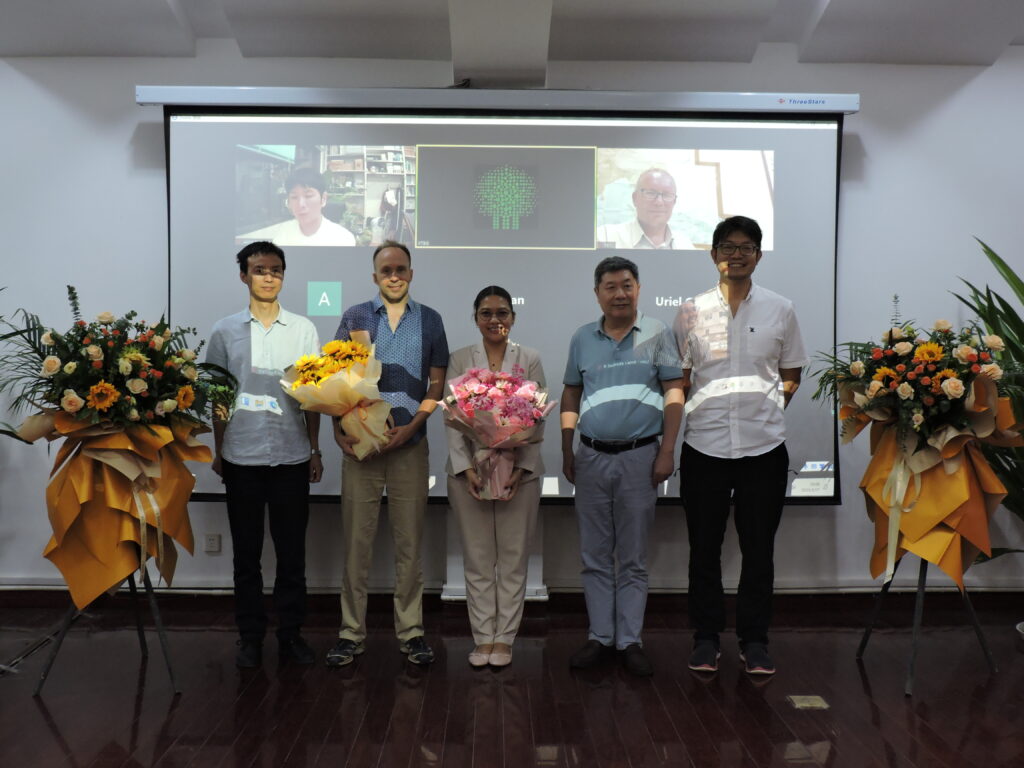We are currently seeking to fill TWO POSTDOC POSITIONS in our lab, the Community Ecology & Conservation Group, at Xishuangbanna Tropical Botanical Garden, Chinese Academy of Sciences. The research considers the importance of small forest fragments in long-term resilience of vertebrate-dispersed tree species in a tropical forest landscape, Xishuangbanna, Southwest China, for which we have just received significant research grant support.
Project Background
Most forest fragments are small, and there is an ongoing debate as to whether they can sustain local sub-populations of trees, and whether they can contribute to species population stability in the landscape, by providing stepping stones between larger fragments. The problem is made more complex by the fact that vertebrate-dispersed tree species depend on vertebrates of different sizes. Large vertebrate-dispersed species are considered to be especially vulnerable because hunting has extirpated or suppressed their dominant dispersers, and the ability of secondary dispersers to functionally replace them is unclear.
In this study, we seek to understand the fate of several tree species with different vertebrate-dispersal modes in small fragments that lie between larger fragments. We are already using disperser assessments and seed fate analyses to understand recruitment success of the tree species in each fragment.
We are now seeking candidates to:
(1) run population genetics analyses in the fragments to understand the genetic health of the sub-populations and whether genetic exchange between fragments still contributes to genetic diversity in new recruits.
(2) record population dynamics of all size classes of trees in the fragments, and integrate the population genetics work and the juvenile recruitment work to understand long-term fate of the tree species using integral projection modelling techniques.
Fully trained support staff are on hand in the research group to aid with fieldwork.
Postdocs receive an annual salary (gross) of at least 200,000 RMB, with annual increments possible, subject to satisfactory progress. Accommodation is provided by the institute for a very nominal fee.
Applicants should have relevant educational experience, in either forest ecology, population genetics, or systems modelling. They should also be in good physical condition as the forest fragment terrain is variable. Candidates who pass initial assessment by the PI will need to pass an online panel interview before formal approval by the institute.
Expressions of interest, should be emailed to Professor Kyle Tomlinson (kyle.tomlinson@xtbg.org.cn), and should include an indication of which research topics you are interested in applying for, what relevant experience you have to support your application, and a full CV to back the expression of interest.
More information about the research group can be found at: https://communityecologyconservation.com/
Category Archives: Uncategorized
NEW PAPER OUT
Yang, J., Fan, H., He, Y., Wang, G., Cao, M. and Swenson, N.G., (2024). Functional genomics and co‐occurrence in a diverse tropical tree genus: The roles of drought‐and defence‐related genes. Journal of Ecology. https://doi.org/10.1111/1365-2745.14255
Abstract
- Tropical tree communities are among the most diverse in the world. A small number of genera often disproportionately contribute to this diversity. How so many species from a single genus can co-occur represents a major outstanding question in biology. Niche differences are likely to play a major role in promoting congeneric diversity, but the mechanisms of interest are often not well-characterized by the set of functional traits generally measured by ecologists.
- To address this knowledge gap, we used a functional genomic approach to investigate the mechanisms of co-occurrence in the hyper-diverse genus Ficus. Our study focused on over 800 genes related to drought and defence, providing detailed information on how these genes may contribute to the diversity of Ficus species.
- We find widespread and consistent evidence of the importance of defence gene dissimilarity in co-occurring species, providing genetic support for what would be expected under the Janzen-Connell mechanism. We also find that drought-related gene sequence similarity is related to Ficus co-occurrence, indicating that similar responses to drought promote co-occurrence.
- Synthesis. We provide the first detailed functional genomic evidence of how drought- and defence-related genes simultaneously contribute to the local co-occurrence in a hyper-diverse genus. Our results demonstrate the potential of community transcriptomics to identify the drivers of species co-occurrence in hyper-diverse tropical tree genera.
For more details on papers published from this group, click here.
NEW PAPER OUT
This is a paper published in Nature and co-authored by Dr. Kyle W. Tomlinson, the head of the group.
Cooper, D.L.M., Lewis, S.L., Sullivan, M.J.P. et al. Consistent patterns of common species across tropical tree communities. Nature (2024). https://doi.org/10.1038/s41586-023-06820-z
Consistent patterns of common species across tropical tree communities
Abstract
Trees structure the Earth’s most biodiverse ecosystem, tropical forests. The vast number of tree species presents a formidable challenge to understanding these forests, including their response to environmental change, as very little is known about most tropical tree species. A focus on the common species may circumvent this challenge. Here we investigate abundance patterns of common tree species using inventory data on 1,003,805 trees with trunk diameters of at least 10 cm across 1,568 locations in closed-canopy, structurally intact old-growth tropical forests in Africa, Amazonia and Southeast Asia. We estimate that 2.2%, 2.2% and 2.3% of species comprise 50% of the tropical trees in these regions, respectively. Extrapolating across all closed-canopy tropical forests, we estimate that just 1,053 species comprise half of Earth’s 800 billion tropical trees with trunk diameters of at least 10 cm. Despite differing biogeographic, climatic and anthropogenic histories7, we find notably consistent patterns of common species and species abundance distributions across the continents. This suggests that fundamental mechanisms of tree community assembly may apply to all tropical forests. Resampling analyses show that the most common species are likely to belong to a manageable list of known species, enabling targeted efforts to understand their ecology. Although they do not detract from the importance of rare species, our results open new opportunities to understand the world’s most diverse forests, including modelling their response to environmental change, by focusing on the common species that constitute the majority of their trees.
For more details on papers published from this group, click here.
NEW PAPER OUT
Maurin, O., Anest, A., Forest, F., Turner, I., Barrett, R. L., Cowan, R. C., Wang, L., Tomlinson, K. W., & Charles-Dominique, T. (2023). Drift in the tropics: Phylogenetics and biogeographical patterns in Combretaceae. Global Ecology and Biogeography, 00, 1–13. https://doi.org/10.1111/geb.13737
Abstract
Aim
The aim of this study was to further advance our understanding of the species-rich, and ecologically important angiosperm family Combretaceae to provide new insights into their evolutionary history. We assessed phylogenetic relationships in the family using target capture data and produced a dated phylogenetic tree to assess fruit dispersal modes and patterns of distribution.
Location
Tropical and subtropical regions.
Time Period
Cretaceous to present.
Major Taxa Studied
Family Combretaceae is a member of the rosid clade and comprises 10 genera and more than 500 species, predominantly assigned to genera Combretum and Terminalia, and occurring on all continents and in a wide range of ecosystems.
Methods
We use a target capture approach and the Angiosperms353 universal probes to reconstruct a robust dated phylogenetic tree for the family. This phylogenetic framework, combined with seed dispersal traits, biome data and biogeographic ranges, allows the reconstruction of the biogeographical history of the group.
Results
Ancestral range reconstructions suggest a Gondwanan origin (Africa/South America), with several intercontinental dispersals within the family and few transitions between biomes. Relative abundance of fruit dispersal types differed by both continent and biome. However, intercontinental colonizations were only significantly enhanced by water dispersal (drift fruit), and there was no evidence that seed dispersal modes influenced biome shifts.
Main Conclusions
Our analysis reveals a paradox as drift fruit greatly enhanced dispersal distances at intercontinental scale but did not affect the strong biome conservatism observed.
For more details on papers published from this group, click here.
NEW PAPER OUT
Quibod MNRM, Gelin U, van Langevelde F, Tomlinson KW*. 2023. Diet-specific responses of skull traits to moisture gradients in bovids and cervids. Linnean Society Journal for Zoological Research. DOI: 10.1093/zoolinnean/zlad068
Abstract
Feeding efficiency of mammalian herbivores is associated with skull traits known to differ between feeding guilds. As climate is known to affect the architecture and functional traits of plants, skull morphology may change as plant traits change along climate gradients. We tested whether skull traits of more than 70% of the extant bovid and cervid species are related to aridity, and whether these relationships differ across feeding guilds (browser, grazer, mixed feeder). We used muzzle width to represent food ingestion and masseteric fossa length to represent oral processing. For the models without phylogeny, both muzzle width and masseteric fossa length increased towards wetter climates for grazers, but not for mixed feeders or browsers. These patterns suggest that grazer diets may change more dramatically across aridity gradients than the other two groups, possibly linked to changes in both the architecture and toughness of grasses. In models accounting for phylogeny, no changes in either trait across aridity gradient were found, which appeared to be due to subfamily differentiation along the aridity gradient. Our results suggest that deeper insights into the evolution of herbivore skulls may be achieved by using quantified diet data to directly test plant trait effects on skull morphology.
For more details on papers published from this group, click here.
THREE NEW PHD GRADUATES
Congratulations to Theo Lefebvre, Jan Sher, and Ninya Quibod who successfully defended their PhD dissertations and will graduate from their PhD degrees!
NEW PAPER OUT
Wang X, Fan H, Phoncharoen W, Gelin U, Tomlinson KW. 2023. Leaf chemistry of architecturally defended plants responds more strongly to soil phosphorus variation than non-architecturally defended ones. Physiologia Plantarum. https://doi.org/10.1111/ppl.13856
(All individual level data is available at https://doi.org/10.57760/sciencedb.07154)
Abstract
Plants utilize a mixture of defence types in response to herbivores, including physical, chemical, and biological defences. Among chemical defences, phenolics are well-known to inhibit digestion and are highly variable across plant species and resource gradients. There are prominent hypotheses predicting the potential change of phenolics in response to soil nutrients, but most focus on nitrogen (N) and none consider their interaction with defence strategies. We proposed an updated theoretical model that incorporates defence types and predicts their relative advantages under herbivore attack. We studied intraspecific leaf chemistry of several architecturally defended and non-architecturally defended species growing together across four sites with varying soil chemistry. We measured individual-level leaf concentrations of carbon, nitrogen, phosphorus (P), potassium (K), and phenolics, and site-level soil N, P, and K. We found that architectural defenders had lower phenolics and higher P than non-architectural defenders across locations. Relationships between soil nutrients and leaf chemistry were steeper in architectural defenders. Most leaf nutrients and phenolics showed significant relationships with soil P, and only leaf P was related to its respective soil resource. Within leaves, phenolics were negatively related to leaf N in both groups but only negatively related to leaf P for architectural defenders. Our results suggest that architectural defenders are less able to accumulate phenolic defences in high P soils than non-architectural defender. One possible explanation is that phenolic production is limited in P-rich soils via active phloem loading, but only in architectural defenders that have defence options other than chemical ones.
NEW PAPER OUT
Roeder, M., Dossa, G. G. O., Cornelissen, J. H. C., Yang, X., Nakamura, A., & Tomlinson, K. W., 2022. Liana litter decomposes faster than tree litter in a multispecies and multisite experiment. Journal of Ecology, 00, 1– 15. https://doi.org/10.1111/1365-2745.13960
Abstract
- Lianas account for a small fraction of forest biomass, but their contribution to leaf or litter biomass and thus to food webs can be substantial. Globally liana exhibit fast life-history traits. Thus, liana litter may decompose faster than tree litter, and could enhance the decomposition of tree litter (complementarity effect). The differences in decomposition may also vary with mesofauna access or across forest communities. The contribution of these factors to nutrient biogeochemical cycling is poorly understood.
- We examined the decomposition of litter of 20 liana and 20 tree species of three different tropical forest communities in southern China, over 1 year. (i) We incubated the litter in bags with coarse and fine mesh to distinguish mesofaunal and microfaunal effects. (ii) We used single-species litter bags to compare decomposition rates of lianas and trees, to test which functional traits best explained decomposition, and whether those traits differed between lianas and trees, and among forest types. (iv) We used mixed-species litter bags to test whether liana litter enhances decomposition in litter mixtures. (v) We evaluated how leaf litter nutrients decayed in relation to litter mass.
- Litter decayed faster in coarse-mesh than fine-mesh bags, but there was no interaction effect with forest type or growth form. Liana litter decayed faster than tree litter in single-species bags with mesofauna access and in mixed bags (liana-only mix, tree-only mix) without mesofauna. Lianas had higher nitrogen content and specific leaf area and lower leaf dry matter content (LDMC) and toughness than trees. Decomposition rate was significantly negatively related to LDMC. Litter of evergreen broadleaved forest decomposed slower than that of other forest types. Liana litter did not enhance the decomposition of tree litter in mixtures. Liana litter released calcium slightly faster than trees.
- Synthesis: Leaf litter decomposes faster for lianas than trees, despite high variability of traits and decomposition rates within each growth form and overlap between growth forms, and we found no evidence for the complementarity hypothesis. Our study sheds light on the potential role of lianas within brown food webs and their importance on terrestrial biogeochemistry.
graduation of 3 students
Congratulations to Chu Yingying, Sedricke Lapuz, and Artémis Anest who are PhD graduates!



NEW PAPER OUT
Lefebvre T, Charles-Dominique T, Tomlinson KW*., 2022. Trunk spines of trees: a physical defence against bark removal and climbing by mammals? Annals of Botany. 5: 541-554 https://doi.org/10.1093/aob/mcac025
Abstract
Background and Aims
The defensive role of spines has previously been related to leaves, young shoots and reproductive organs. However, some woody species harbour spines on their trunks where none of those organs are present. Several explanations are plausible: they could be (1) climbing aids, (2) remnants from defence of leaves or reproductive organs during an earlier development phase, or (3) an as-yet undescribed defence. Here we investigate whether they could play a role against either bark feeding or preventing climbing animals accessing food resources in the tree canopy.Methods
We described 31 woody species with spines on their trunk, growing in a botanical garden, to test whether morphological strategies could be identified and suggest what could be their most likely function. As testing their function is difficult experimentally for large pools of species, we performed virtual experiments to evaluate the potential roles of trunk spines against bark removal and climbing animals of different sizes. We then compared for each species and their confamilial non-spiny species the nutritional profiles of leaf, bark and reproductive organs to test whether trunk spines were associated with a nutritious organ (more likely targeted by herbivores).Key Results
We identified four morphological syndromes of trunk spines. Two corresponded to already known functions (anchorage for lianas and crown defence against large ground mammals), and two strategies are newly described trait syndromes with traits suggesting a defence against bark feeding and climbing mammals. By simulation, we show how each strategy could translate into defence against debarking and prevent herbivores from climbing.Conclusions
We identified trunk spine strategies and the criteria to classify them, their most likely function and the likely feeding mode and size of animal against which different trunk spine strategies may be effective. We discuss further perspectives for testing their function and their ecological significance.



